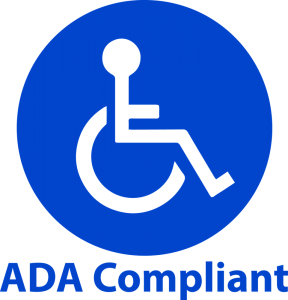
Is your event compliant with the Americans with Disabilities Act?
Whether you are hosting an art exhibition, a concert, a play or a party for SWAN Day, there are many steps you can take to make sure that you are welcoming all artists and audience members, including those with physical disabilities.
If you are renting a public facility for your event, it may already be accessible. The Americans with Disabilities Act (ADA), which was passed in 1990, forbids discrimination against people with disabilities. This means that when new public facilities are built, they must comply with accessibility codes, and older facilities must make “reasonable modifications” to accommodate people with disabilities.
Your first step is to figure out how accessible your event will be to people with different kinds of disabilities. For instance:
- Are there stairways or narrow aisles that will be a barrier to people in wheelchairs or with other mobility issues?
- Are the restrooms accessible?
- If you have special seating areas for wheelchairs, can the tickets for those areas be purchased easily online?
- Does the facility have a system for assisted listening?
- Can you make the program available in advance so that a visually impaired person could find someone to read it to them?
- Can a person with disabilities get to your concession booth easily if they want a cookie at intermission?
For a comprehensive guide on making events accessible, ADA.gov offers a fantastic checklist:
The ADA Checklist for Existing Facilities. This checklist outlines your priorities as an event organizer, and then goes into detail about each priority.
You may not be able to make every event completely accessible, but being aware, consistently publicizing whether your event is accessible or not, and being willing to help however you can will go a long way towards making people feel welcome.
A Beginner’s Overview of Access for Exhibits by Sheila L. Kalkbrenner
Visual Artist, Disability Advocate & SWAN Days Allegany County Organizer
The key word is accessible—physically accessible. Can someone with a wheelchair, or a cane, maneuver into and around your event?
Achieving accessibility can be a process—I’m still working to get my own art studio completely accessible! Start where you can. If you can’t invest in having the front of your building changed, have a place on your website or in your event marketing letting people know and asking them to call ahead. Work with them on ways to make it accessible for them.
If you want to quickly get a sense of how maneuverable your event really is for someone with a disability, go through the event yourself with a blindfold on. This will quickly make it apparent what gets in your way, and what may get in someone else’s way, both for a visually impaired person using a cane, or someone using a cane for a different reason. Watch out for things on the floor—not just wires and objects, but carpet that curls, door edges that may get in the way of a cane, and chairs sticking out in weird places.
Another quick but useful test is the Yardstick Test: walk through your event with a yardstick held in front of you, so you can see if all paths are at least 36” wide. Even if your hallways and doorways are wide enough, have you placed any objects (like sculptures in an art show, or tables) that may get in the way? A person in a wheelchair, or walking unsteadily on a cane, wants to be able to maneuver through your space without disturbing anything.
If you are willing to invest in some small upgrades, hand railings can be useful for people with many types of disabilities. Railings are important for ensuring an accessible restroom, but can also be helpful for someone navigating around a doorway or in another area without anything nearby to use for support.
Railings are particularly important in a visual art exhibition; when you’re walking through a show where art is hung on the wall, you don’t want to have to use the wall itself for support. It feels awkward to put your hand on the wall—you don’t want to leave handprints, or disturb the artwork. If there is a railing, it can make a huge difference for someone with balance problems. If I go out and am having trouble, I don’t want to be conspicuous.
(Please note: This is NOT a comprehensive list, but rather offers a place to start if you haven’t given accessibility much thought yet. Please look into local regulations for your facility and type of event, and talk with your artists and audience members about what types of accessibility they need.)

